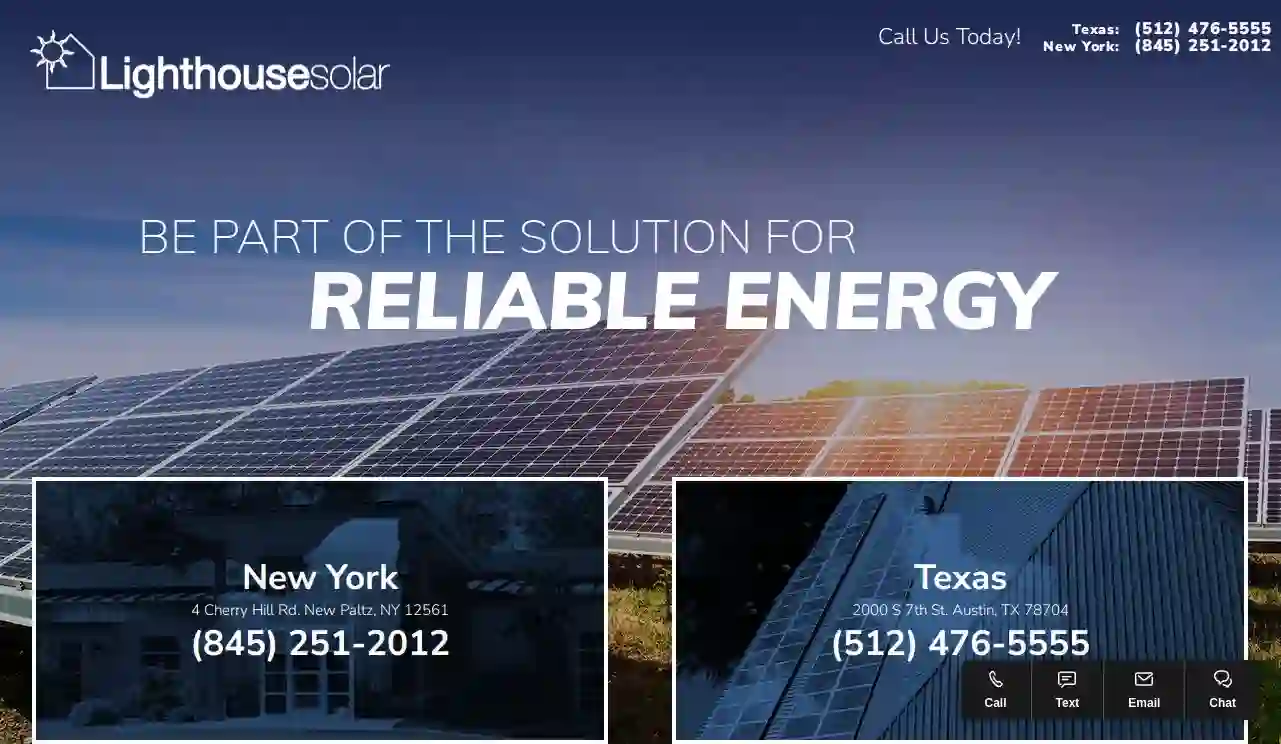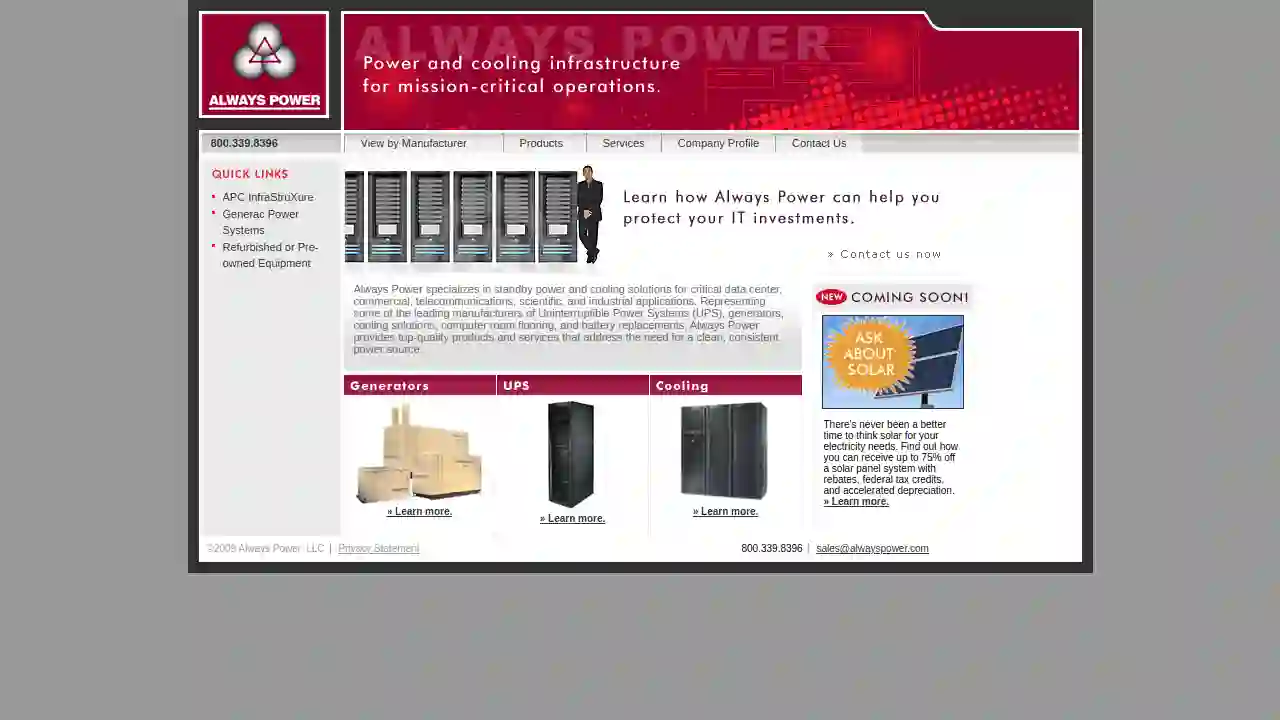Solar Installers Brownfield
Find top Solar Installation Companies in Brownfield
Get up to 3 Solar Installer quotes for your project today! Compare profiles, reviews, accreditations, portfolio, etc... and choose the best offer.

Lighthouse Solar
New Paltz, NY, USA, 4 Cherry Hill Rd, 12561, USLighthouse Solar is a leading provider of reliable energy solutions, offering a range of services to help individuals and businesses transition to sustainable energy sources. With offices in Texas and New York, the company is dedicated to providing high-quality solar panel installations and energy storage solutions. Their team of experienced professionals is committed to delivering exceptional customer service and ensuring that clients receive the best possible solutions for their energy needs.
- Services
- Why Us?
- Accreditations
- Our Team
- Testimonials
- Gallery
Get Quote
SolarTek Energy of San Antonio
3.73 reviewsGrenada Mississippi, 38901, Grenada, USSolarTEK Energy is dedicated to being your first choice solar pool heating company in Texas. Our Texas Solar Pool Heating Experts are highly dedicated to providing top quality solar pool heating solutions that are designed to help you utilize the power of the sun and turn it in to energy that hears your pool for an extended period of the year.
- Services
- Why Us?
- Accreditations
- Our Team
- Testimonials
- Gallery
Get Quote
Sunspear Energy | Solar Contractor Company
4.935 reviews345 N Nimitz Hwy, Ste A, Honolulu, HI 96817, 96817, USSunspear Energy is a full-service solar and battery storage solutions company based in Hawaii. We offer turn-key solar power system design, installation, and financing to homeowners, commercial businesses, non-profit organizations, and public sector entities. Our mission is to strengthen our local community by enabling access to clean distributed energy resources, helping our customers achieve financial and energy independence.
- Services
- Why Us?
- Accreditations
- Our Team
- Testimonials
- Gallery
Get Quote
SolarWind Panel Installation San Antonio LLC
57 reviewsSan Antonio, TX, 613 E Locust St, 78212, USSolarWind Panel Installation San Antonio LLC is a leading provider of solar panel installation services in San Antonio, Texas. Our mission is to provide high-quality, efficient, and affordable solar solutions to our clients. With years of experience in the industry, our team of experts is dedicated to ensuring that our clients receive the best possible service and results. We are fully accredited and insured, and we pride ourselves on our commitment to customer satisfaction.
- Services
- Why Us?
- Accreditations
- Our Team
- Testimonials
- Gallery
Get Quote
Houston Solar Energy
55 reviewsSte 220, Houston, TX, 8990 Kirby Drive, 77054, USHouston Solar Energy specializes in medium-scale commercial and industrial solar systems, having successfully installed over 300 solar systems throughout the greater Houston area. They offer custom-designed projects for specific roof and electrical consumption patterns, focusing on trusted relationships built on referrals from satisfied customers.
- Services
- Why Us?
- Accreditations
- Our Team
- Testimonials
- Gallery
Get Quote
REC Solar Hawaii
3450 Broad St #105, San Luis Obispo, 93401, USDiscover the expertise and passion that have made REC Solar a trusted commercial solar company for over two decades. Together, let’s harness the power of the sun and take your organization on a transformative journey toward a brighter, sustainable future.
- Services
- Why Us?
- Accreditations
- Our Team
- Testimonials
- Gallery
Get Quote
Connexa
4.49 reviewsConnexa, Comfort, TX, 147 US-87, 78013, USConnexa is a three-time Inc. 5000 award-winning company that specializes in manufacturing innovative remote power products, including battery-based solar power systems and UPS critical power backup systems. The company is vertically integrated from metals fabrication to electrical wiring and assembly, enabling the easy and rapid deployment of field electronics globally. Connexa is committed to upholding the highest standards in the industry by evolving power and empowering customers. The company's core values include passion, integrity, empowerment, ownership, vulnerability, continuous improvement, transparency, and customer-driven approach. Connexa is also dedicated to environmental concern, safety, and social responsibility.
- Services
- Why Us?
- Accreditations
- Our Team
- Testimonials
- Gallery
Get Quote
EnerG Solar
3.338 reviews1910 Pacific Ave, Dallas, TX 75204, 75204, USEnerG, one of the most reputable solar providers in the nation, aims to bring sustainable energy to homes and businesses to achieve a healthier environment. Our goal is to help as many people as we can move into a more sustainable future that is helpful to the environment, and to your wallet. Being in the industry for years has taught us to treat our clients how we expect to be treated, so every time you deal with us, you know you're receiving personal care.
- Services
- Why Us?
- Accreditations
- Our Team
- Testimonials
- Gallery
Get Quote
Texas Engineered Solar
528 reviewsSuite# 128, 8562 NE Interstate 410 Loop, San Antonio, 78219, USTexas Engineered Solar is a certified veteran-owned small business with over 20 years combined experience in the solar industry. Our founder honorably served in the USAF for nine years and several of our employees have also served in the US Armed Forces. We’re proud to share our solar expertise with Military City USA and help our fellow Texans gain their energy independence!
- Services
- Why Us?
- Accreditations
- Our Team
- Testimonials
- Gallery
Get Quote
Always Power
El Paso, USAlways Power specializes in standby power and cooling solutions for critical data center, commercial, telecommunications, scientific, and industrial applications. Representing some of the leading manufacturers of Uninterruptible Power Systems (UPS), generators, cooling solutions, computer room flooring, and battery replacements, Always Power provides top-quality products and services that address the need for a clean, consistent power source.
- Services
- Why Us?
- Gallery
Get Quote
Over 4,210+ Solar Installers on our platform
Our solar contractors operate in Brownfield & surroundings!
SolarCompaniesHub has curated and vetted the Best Solar Installers in Brownfield. Find a trustworthy contractor today.
Frequently Asked Questions About Solar Installers
- String Inverters: Connect multiple panels in a series (a 'string'). A cost-effective option for simple systems, but a single panel issue can affect the entire string.
- Microinverters: Attach to each individual solar panel, maximizing energy production even if some panels are shaded. They are more expensive but offer greater efficiency and monitoring capabilities.
- Power Optimizers: Similar to microinverters, but less expensive. They optimize the output of each panel and provide individual panel monitoring, but a central inverter is still required.
- Hybrid Inverters: Combine a solar inverter with a battery charge controller, allowing for seamless integration of battery storage.
- Adequate Sunlight: Unobstructed sunlight for a significant portion of the day.
- Sufficient Space: Enough space to accommodate the desired number of panels.
- Structural Integrity: A strong roof structure capable of supporting the weight of the panels.
- Appropriate Orientation and Tilt: Ideally, the roof should face south (in the Northern Hemisphere) or north (in the Southern Hemisphere) with a tilt angle close to the latitude of your location. However, other orientations and tilts can still be effective.
Will solar panels work during cloudy days or at night?
What are the different types of solar inverters?
How do I know if my roof is suitable for solar panels?
How do solar panels work?
Will solar panels work during cloudy days or at night?
What are the different types of solar inverters?
- String Inverters: Connect multiple panels in a series (a 'string'). A cost-effective option for simple systems, but a single panel issue can affect the entire string.
- Microinverters: Attach to each individual solar panel, maximizing energy production even if some panels are shaded. They are more expensive but offer greater efficiency and monitoring capabilities.
- Power Optimizers: Similar to microinverters, but less expensive. They optimize the output of each panel and provide individual panel monitoring, but a central inverter is still required.
- Hybrid Inverters: Combine a solar inverter with a battery charge controller, allowing for seamless integration of battery storage.
How do I know if my roof is suitable for solar panels?
- Adequate Sunlight: Unobstructed sunlight for a significant portion of the day.
- Sufficient Space: Enough space to accommodate the desired number of panels.
- Structural Integrity: A strong roof structure capable of supporting the weight of the panels.
- Appropriate Orientation and Tilt: Ideally, the roof should face south (in the Northern Hemisphere) or north (in the Southern Hemisphere) with a tilt angle close to the latitude of your location. However, other orientations and tilts can still be effective.